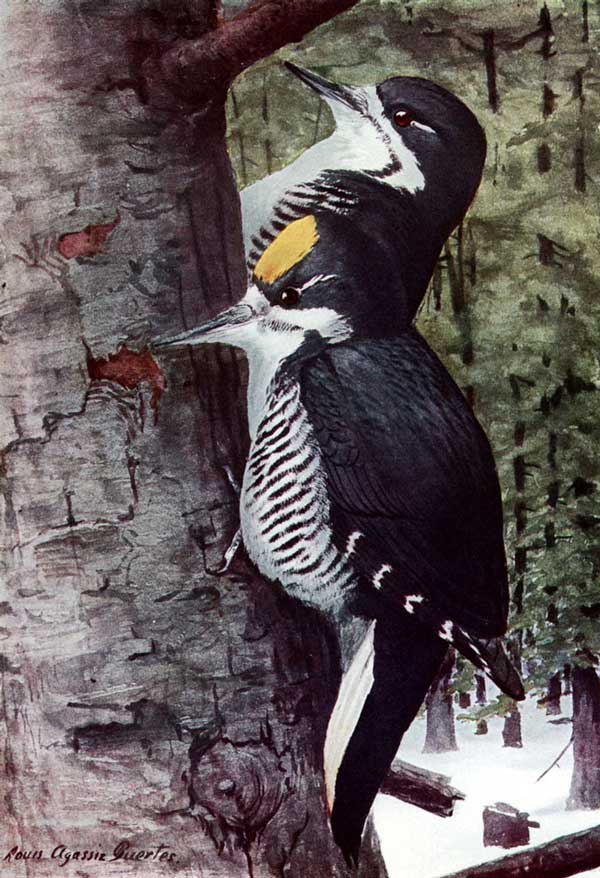
Picoides arcticus
Superregnum: Eukaryota
Cladus: Unikonta
Cladus: Opisthokonta
Cladus: Holozoa
Regnum: Animalia
Subregnum: Eumetazoa
Cladus: Bilateria
Cladus: Nephrozoa
Superphylum: Deuterostomia
Phylum: Chordata
Subphylum: Vertebrata
Infraphylum: Gnathostomata
Megaclassis: Osteichthyes
Cladus: Sarcopterygii
Cladus: Rhipidistia
Cladus: Tetrapodomorpha
Cladus: Eotetrapodiformes
Cladus: Elpistostegalia
Superclassis: Tetrapoda
Cladus: Reptiliomorpha
Cladus: Amniota
Classis: Reptilia
Cladus: Eureptilia
Cladus: Romeriida
Subclassis: Diapsida
Cladus: Sauria
Infraclassis: Archosauromorpha
Cladus: Crurotarsi
Divisio: Archosauria
Cladus: Avemetatarsalia
Cladus: Ornithodira
Subtaxon: Dinosauromorpha
Cladus: Dinosauriformes
Cladus: Dracohors
Cladus: Dinosauria
Cladus: Saurischia
Cladus: Eusaurischia
Subordo: Theropoda
Cladus: Neotheropoda
Cladus: Averostra
Cladus: Tetanurae
Cladus: Avetheropoda
Cladus: Coelurosauria
Cladus: Tyrannoraptora
Cladus: Maniraptoromorpha
Cladus: Maniraptoriformes
Cladus: Maniraptora
Cladus: Pennaraptora
Cladus: Paraves
Cladus: Eumaniraptora
Cladus: Avialae
Infraclassis: Aves
Cladus: Avebrevicauda
Cladus: Pygostylia
Cladus: Ornithothoraces
Cladus: Ornithuromorpha
Cladus: Carinatae
Parvclassis: Neornithes
Cohors: Neognathae
Cladus: Neoaves
Ordo: Piciformes
Familia: Picidae
Subfamilia: Picinae
Genus: Picoides
Species: Picoides arcticus
Name
Picoides arcticus (Swainson, 1832)
Synonymy
Picus (Apternus) arcticus (protonym)
References
Fauna Boreali-Americana 2: 313, pl. LVII.
Vernacular names
čeština: Datlík černohřbetý
dansk: Sortrygget Flagspætte
Deutsch: Schwarzrückenspecht
English: Black-backed Woodpecker
español: Pico ártico
eesti: Mustselg-laanerähn
suomi: Nokitikka
français: Pic à dos noir
magyar: Feketehátú hőcsik
italiano: Picchio artico
日本語: セグロミユビゲラ
Nederlands: Zwartrugspecht
norsk: Svartryggspett
polski: Dzięcioł północny
русский: Североамериканский дятел
slovenčina: Ďubník čiernochrbtý
svenska: Svartryggad hackspett
українська: Дятел чорноспинний
中文: 黑背啄木鸟
The black-backed woodpecker (Picoides arcticus), also known as the Arctic three-toed woodpecker, is a medium-sized woodpecker (23 cm (9.1 in) long) inhabiting the forests of North America.
Taxonomy
The black-backed woodpecker was described and illustrated by the English naturalist William John Swainson in 1832 from a specimen collected near the source of the Athabasca River on the eastern slopes of the Rocky Mountains in Alberta, Canada. He coined the binomial name Picus arcticus.[2] The specific epithet arcticus is the Latin word for "northern" or "arctic".[3] The black-backed woodpecker is now placed in the genus Picoides which was erected by the French naturalist Bernard Germain de Lacépède in 1799.[4][5] The species is monotypic: no subspecies are recognised.[5]
Description
The plumage of adults is black on the head, back, wings and rump. They are white from the throat to the belly; the flanks are white with black bars. Their tail is black with white outer feathers. There is an element of sexual dimorphism in the plumage, with the adult male possessing a yellow cap. Unlike all other woodpeckers except the related American and Eurasian three-toed woodpeckers, this species has three-toed feet.
Measurements:[6]
Length: 9.1 inches (23 cm)
Weight: 2.1–3.1 oz (60–88 g)
Wingspan: 15.8–16.5 in (40–42 cm)
Habitat and breeding
Their breeding range is boreal forest across Canada, Alaska, the Northwestern United States, as well as northern Wisconsin,[7] the Adirondacks in New York, New England, Minnesota,[8] and Upper Michigan.[9] In particular the species is a burnt-forest specialist, feeding on the outbreaks of wood-boring beetles that feed on recently burnt trees.[10] The most important wood boring beetles taken are in the families Cerambycidae and Buprestidae, along with engraver beetles and the mountain pine beetle. Most food is obtained by pecking, a smaller proportion is obtained by gleaning off branches. Black-backed woodpeckers are generally non-migratory but historically have undertaken intermittent irruptions.
Nest excavation occurs in April and May; a fresh nest is drilled each year into the sapwood of dead trees. Abandoned nests are used by other species of bird to nest in. The female lays three or four eggs, and incubation duties are shared between both parents, although the male alone incubates during the night. Upon hatching the altricial chicks are brooded until the nestling phase. Both parents feed the chicks, which take about 24 days to fledge.
Vocalization
The call note of the black-backed woodpecker is a single, sharp pik, and is lower pitched than the call of the American three-toed woodpecker.
References
BirdLife International (2016). "Picoides arcticus". IUCN Red List of Threatened Species. 2016: e.T22681181A92895828. doi:10.2305/IUCN.UK.2016-3.RLTS.T22681181A92895828.en. Retrieved 11 November 2021.
Swainson, William John; Richardson, J. (1831). Fauna boreali-americana, or, The zoology of the northern parts of British America. Vol. Part 2. The Birds. London: J. Murray. p. 313. The title page bears the year 1831 but the volume did not appear until 1832.
Jobling, James A. (2010). The Helm Dictionary of Scientific Bird Names. London: Christopher Helm. p. 53. ISBN 978-1-4081-2501-4.
Lacépède, Bernard Germain de (1799). "Tableau des sous-classes, divisions, sous-division, ordres et genres des oiseux". Discours d'ouverture et de clôture du cours d'histoire naturelle (in French). Paris: Plassan. p. 7. Page numbering starts at one for each of the three sections.
Gill, Frank; Donsker, David; Rasmussen, Pamela, eds. (2020). "Woodpeckers". IOC World Bird List Version 10.1. International Ornithologists' Union. Retrieved 1 June 2020.
"Black-backed Woodpecker Identification, All About Birds, Cornell Lab of Ornithology". allaboutbirds.org. Retrieved 26 September 2020.
ebird. "eBird Range Map--Black-backed Woodpecker". ebird.org. Retrieved 10 July 2017.
"Minnesota Breeding Bird Map List: Minnesota DNR". dnr.state.mn.us. Retrieved 10 July 2017.
"TaxonomicListing". mibirdatlas.org. Archived from the original on 6 August 2017. Retrieved 10 July 2017.
Gillis, Justin (6 August 2017). "Let Forest Fires Burn? What the Black-Backed Woodpecker Knows (Published 2017)". The New York Times. Archived from the original on 26 May 2023.
Dixon, Rita D., and Victoria A. Saab. (2000). Black-backed woodpecker (Picoides arcticus), The Birds of North America Online (A. Poole, Ed.). Ithaca: Cornell Lab of Ornithology; Retrieved from the Birds of North America Online: http://bna.birds.cornell.edu/bna/species/509
National Geographic's Field Guide to the Birds of North America, Third Edition; Describes call note
Retrieved from "http://en.wikipedia.org/"
All text is available under the terms of the GNU Free Documentation License

